What are the different species of gorillas? Gorillas are the largest of the great apes and one of the closest relatives of man – after bonobos and chimpanzees. Gorillas share 98% of their genetic code with humans. Gorillas display many of the behaviors/emotions common with humans such as sadness and laughter. Wild Gorillas are only found in some of Africa’s tropical forests, wetlands, marshes, highlands and mountains.
Gorillas are powerful primates with muscular arms, thick chests, large nostrils and black/brownish hair. Hair covers the entire body except for the face, hands, feet and chest (for old silverbacks). Gorillas walk 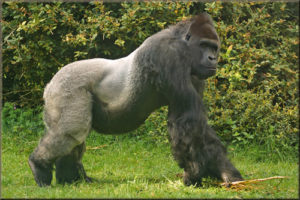 with all four legs most of the time but can stand erect especially when feeding on tree bark or displaying dominance. Adult male gorillas are called silverbacks because of the silver/gray hairs on their back. Silverbacks are larger than the females and can weigh between 135 to 220 kilograms in the wild. Those in captivity may grow fatter and heavier because of less exercise or space in which to exercise. Because of their weight, adult gorillas avoid climbing trees if they can. It is the young that climb and sleep on short tree branches most of the time.
with all four legs most of the time but can stand erect especially when feeding on tree bark or displaying dominance. Adult male gorillas are called silverbacks because of the silver/gray hairs on their back. Silverbacks are larger than the females and can weigh between 135 to 220 kilograms in the wild. Those in captivity may grow fatter and heavier because of less exercise or space in which to exercise. Because of their weight, adult gorillas avoid climbing trees if they can. It is the young that climb and sleep on short tree branches most of the time.
Gorillas live in groups led by a dominant silverback. There are cases where a group may be led by two related silverbacks but this is not common in some gorilla subspecies. A gorilla group or family can contain between 4 to 30 individuals who can live up to 35 years in the wild (45 in captivity). The group may include younger males, juveniles, females and their babies. The stability of a gorilla group depends entirely on the bond between the females and the dominant silverback. Mating in gorillas is often initiated by the female as soon as she is fertile. Young females always leave the group once they are sexually maturity to join lone males or other groups. This movement is to avoid inbreeding and competition for the attention of the dominant Silverback. A mature male may stay with his group of birth but are in most cases driven away by the dominant silverback to start a life alone or join other bachelor males. In their lonely life, they will attempt to snatch females from stable groups. If a male succeeds in staying with his family, he will lay low, mate with some of the females and waits to take over from his aged father.
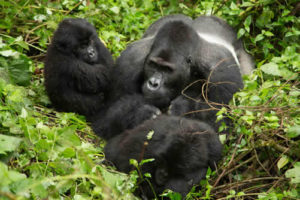 Although chimpanzees are thought to be the more intelligent ape, gorillas are calmer, more peaceful, persistent and wiser. Their groups are far more stable with members very loyal to each other compared to chimpanzees. Chimpanzees are much more aggressive and the dominant male has a lot of work to do in containing group members. Even though they display a calm and collected demeanor, a gorilla has a terrifying bark/roar when threatened. The silverback will attempt to protect the family by scaring away any intruders using aggressive displays, roars, tearing at vegetation, running sideways, slapping the ground or chest beating. The silverback will also appear to attack the intruder before withdrawing.
Although chimpanzees are thought to be the more intelligent ape, gorillas are calmer, more peaceful, persistent and wiser. Their groups are far more stable with members very loyal to each other compared to chimpanzees. Chimpanzees are much more aggressive and the dominant male has a lot of work to do in containing group members. Even though they display a calm and collected demeanor, a gorilla has a terrifying bark/roar when threatened. The silverback will attempt to protect the family by scaring away any intruders using aggressive displays, roars, tearing at vegetation, running sideways, slapping the ground or chest beating. The silverback will also appear to attack the intruder before withdrawing.
Gorillas feed mainly on leaves, fruits and shoots. They are mostly vegetarian but will catch certain ants/insects if they can. Gorillas need to eat a lot of vegetation in a day to get satisfied. For this reason, they may move for a few kilometers in search of food each. Gorillas are not territorial and this is probably because most groups live a life of plenty in dense forests. Gorilla Groups may share the same territory but will generally avoid each other. Group mingling and joint feeding has only been observed among the western lowland gorilla. After feeding for much of the morning, members of the group will build temporary nets for an afternoon nap. After the afternoon nap, feeding continues up to late in the afternoon. The group will then build night nests by bending foliage and other tree branches to come up with something comfortable. New nests are built every night and can be on the ground or on top of short trees. The silverback almost always sleeps on the ground while infants share nests with their mothers.
Female gorillas reach sexual maturity at the age of about 10 while males do the same at about 15 years. Females tend to give birth every four to five years and after a gestation period of 9 months. The low reproductive rate of gorillas is one of things that make them an endangered species. The female often gives birth to a single infant but twins are a common occurrence. A newly born weighs 2 kilograms at birth and will be carried in the mother’s arm for three months before it gains the strength required to ride on her back.
The greatest threat to gorillas come from humans. Humans destroy gorilla habitats through deforestation and illegal logging. Humans are also threatened by poaching, animal trafficking, human diseases and accidental deaths snares trap other forest animals like giant forest pigs. Gorillas can easily 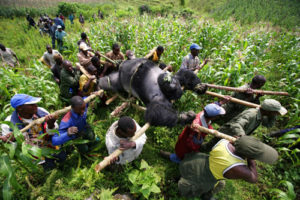 be hunted down for their meat because they do not flee away like chimps. In fact, gorillas will defend their young to the death. Animal traffickers and poachers may need to kill the entire group in order to get hold of a gorilla infant. Trading in wild gorillas is dangerous because it can help in the spread of diseases like Ebola to other gorilla groups and humans. In 2003, it was estimated that a third of western lowland gorilla populations had died from the Ebola virus. How does logging affect gorillas? One is that it exposes the primates. Most of the forests in Africa were vast allowing gorillas to thrive without any human interference. As more trees were cut down for timber and to open farms, gorilla groups started getting into frequent contact with humans. Logging has left some gorilla groups isolated in pockets of forests separated by human farmlands leading to inbreeding because they cannot interact with other gorilla groups. Gorillas are very prone to human diseases. A simple flu/cough, Tuberculosis and scabies can be a death sentence to an entire gorilla family.
be hunted down for their meat because they do not flee away like chimps. In fact, gorillas will defend their young to the death. Animal traffickers and poachers may need to kill the entire group in order to get hold of a gorilla infant. Trading in wild gorillas is dangerous because it can help in the spread of diseases like Ebola to other gorilla groups and humans. In 2003, it was estimated that a third of western lowland gorilla populations had died from the Ebola virus. How does logging affect gorillas? One is that it exposes the primates. Most of the forests in Africa were vast allowing gorillas to thrive without any human interference. As more trees were cut down for timber and to open farms, gorilla groups started getting into frequent contact with humans. Logging has left some gorilla groups isolated in pockets of forests separated by human farmlands leading to inbreeding because they cannot interact with other gorilla groups. Gorillas are very prone to human diseases. A simple flu/cough, Tuberculosis and scabies can be a death sentence to an entire gorilla family.
Several international wildlife organizations, individuals and zoos have taken action to stop the extinction of these great species. Gorilla tours in Africa have helped raise awareness about the plight of gorillas hence attracting the necessary funds for research and conservation. Organizations like the World Wide Fund for Nature (WWF) have helped support national parks by providing advanced tracking equipment and training their staff. Other similar organizations have funded projects that help curb poaching, pet trade and illegal logging. The annual gorilla censuses pulls together resources from several gorilla conservation organizations worldwide to find out their numbers and distributions. Individuals can also sponsor a gorilla or donate to organizations like the Dian Fossey gorilla fund International and the Gorilla Doctors.
Note: The efforts of wildlife conservation Agencies have been hampered by civil unrest, corruption, lack of rule of law and weak enforcement of established lows. Poachers, consumers and traders of bush meat are often given light sentences or never apprehended at all.
Types of Gorillas
The Two Gorilla Species
How many types of gorillas are there? There are two species of gorillas – the Eastern gorilla and the Western gorilla (Gorilla Gorilla). The Western gorillas is the most abundant specie. Their nose structure is different and they have a lighter color than the Eastern gorilla. Western gorillas are further divided into two subspecies – the Cross River Gorilla (G. gorilla diehli) and the Western lowland gorilla (G. gorilla gorilla). The Eastern Gorilla (G. beringei) also has two subspecies – the mountain gorillas (G. beringei beringei) and the Eastern lowland gorilla (G. beringei graueri). The Eastern lowland gorilla is now generally referred to as the Grauer’s gorilla. The Eastern gorillas are the largest of all the apes and are found in Uganda, Rwanda and the Democratic Republic of Congo.
The Four Gorilla Sub-species
Western Lowland gorillas (G. gorilla gorilla)
The Western lowland gorilla lives in the lowland forests of central and west Africa ( Angola, Equatorial Guinea, Central African Republic, Cameroon, Gabon, Democratic Republic of the Congo, the Republic of the Congo and Gabon). They are the smallest but most abundant of all the four gorilla subspecies. It is 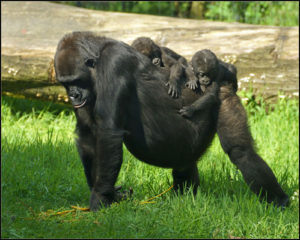 difficult to estimate their correct numbers because they live in some of the largest and densest forests of Africa. It is estimated that over 350,000 remain in the wild. Western lowland gorillas are also the most commonly seen species in zoos and stand out from the two subspecies of eastern gorillas because of their greyish/reddish fur. They have been observed to be more open to inter-group interactions and feeding. Although they are the most numerous of the all the gorilla sub-species, their overall population is believed to have declined by 60% in the last 25 years. Their greatest threat are humans and the Ebola virus which at some point (2003) wiped out over 30 percent of their overall population. You can see the western gorilla in zoos or in one of the national parks in west/Central Africa.
difficult to estimate their correct numbers because they live in some of the largest and densest forests of Africa. It is estimated that over 350,000 remain in the wild. Western lowland gorillas are also the most commonly seen species in zoos and stand out from the two subspecies of eastern gorillas because of their greyish/reddish fur. They have been observed to be more open to inter-group interactions and feeding. Although they are the most numerous of the all the gorilla sub-species, their overall population is believed to have declined by 60% in the last 25 years. Their greatest threat are humans and the Ebola virus which at some point (2003) wiped out over 30 percent of their overall population. You can see the western gorilla in zoos or in one of the national parks in west/Central Africa.
Cross River Gorillas (G. gorilla diehli)
The Cross River Gorilla was classified as a distinct subspecies in the year 2000 and are listed as critically endangered by the IUCN in their 2006 List. Cross River gorillas inhabit a stretch of 3,000 square miles of forested mountains and highlands in Cameroon and Nigeria. They live in the most northern/western part of Africa (considering gorilla dispersion). Cross river gorillas weigh about 440 pounds and can 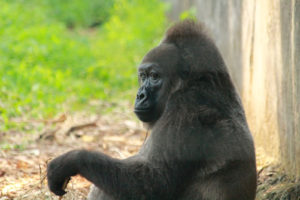 stand up to 5 feet long. They are the most threatened of all the gorilla subspecies and less than 350 remain in the wild. Cross River gorillas are particularly vulnerable to extinction because they occupy a small stretch of land and come into more contact with humans. Because of their frequent contacts with humans, they are more aggressive, elusive and difficult to study. The greatest threat to them is loss of genetic diversity, habitat loss and poaching. Some of the gorilla groups have been left isolated in islands of forests and mountains due to illegal logging. The governments of Cameroon, Nigeria and international wildlife conservation Agencies have acted fast to ensure that they are not wiped out. The WWF has worked with the respective governments to help regrow forests in places where illegally logging and farms had separated gorilla families. Local communities close to the gorilla habitats have also been sensitized about the importance of the primates to the ecosystem and posterity. Gorilla Tourism is not yet open in regards to Cross River gorillas and you cannot see then in zoos.
stand up to 5 feet long. They are the most threatened of all the gorilla subspecies and less than 350 remain in the wild. Cross River gorillas are particularly vulnerable to extinction because they occupy a small stretch of land and come into more contact with humans. Because of their frequent contacts with humans, they are more aggressive, elusive and difficult to study. The greatest threat to them is loss of genetic diversity, habitat loss and poaching. Some of the gorilla groups have been left isolated in islands of forests and mountains due to illegal logging. The governments of Cameroon, Nigeria and international wildlife conservation Agencies have acted fast to ensure that they are not wiped out. The WWF has worked with the respective governments to help regrow forests in places where illegally logging and farms had separated gorilla families. Local communities close to the gorilla habitats have also been sensitized about the importance of the primates to the ecosystem and posterity. Gorilla Tourism is not yet open in regards to Cross River gorillas and you cannot see then in zoos.
The Grauer’s gorilla or Eastern Lowland gorilla (G. beringei graueri)
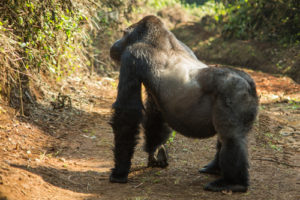 Eastern lowland gorillas are found in the eastern part of the Democratic Republic of Congo. They are found in Kahuzi-Biega National Parks, Odzala-Kokoua National Park, Maiko National Park and areas around the Itombwe Massif. The Graeur’s gorilla is the largest of all the gorilla subspecies. It has a stocky body, a short muzzle and larger hands. Like Mountain gorillas, they have black coats but with shorter hair on the head and body. They are the third most critically endangered species of the three gorilla subspecies. Most of the threats comes from poaching and habitat loss. Their home range has shrunk from 81,000 square miles to only 5,600 square miles in the last two decades alone. About 7,500 Eastern lowland gorillas remain in the wild. You can read more about Eastern lowland gorilla trekking in Congo.
Eastern lowland gorillas are found in the eastern part of the Democratic Republic of Congo. They are found in Kahuzi-Biega National Parks, Odzala-Kokoua National Park, Maiko National Park and areas around the Itombwe Massif. The Graeur’s gorilla is the largest of all the gorilla subspecies. It has a stocky body, a short muzzle and larger hands. Like Mountain gorillas, they have black coats but with shorter hair on the head and body. They are the third most critically endangered species of the three gorilla subspecies. Most of the threats comes from poaching and habitat loss. Their home range has shrunk from 81,000 square miles to only 5,600 square miles in the last two decades alone. About 7,500 Eastern lowland gorillas remain in the wild. You can read more about Eastern lowland gorilla trekking in Congo.
Mountain Gorillas (G. beringei beringei)
Mountain gorillas are one of the two sub-species of the Eastern gorillas. Mountain gorillas are only found in the Virunga Mountain regions of the Democratic Republic of Congo, Rwanda and Uganda. 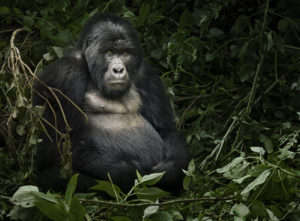 They are not as heavy as the Eastern lowland gorilla and generally live in forests at higher elevations (8,000 to 12,000 feet) and on mountain slopes. Mountain gorillas stand out because of their thick and long hair/fur. The thick coat protects them from the cold temperatures on mountain slopes. Mountain gorillas are the second most endangered of the four gorilla subspecies. They can only be seen in the wilds or at the Senkwekwe Gorilla Orphanage in Congo. Only about 1,000 remain in the wild according to census results from 2018. Mountain Gorillas are also threatened by habitat loss as a result of continues human encroachment on forests and mountain slopes. Some are forced to migrate higher up the cold mountain slopes which could threaten their health. You can read more about where to see mountain gorillas or the facts about mountain gorillas.
They are not as heavy as the Eastern lowland gorilla and generally live in forests at higher elevations (8,000 to 12,000 feet) and on mountain slopes. Mountain gorillas stand out because of their thick and long hair/fur. The thick coat protects them from the cold temperatures on mountain slopes. Mountain gorillas are the second most endangered of the four gorilla subspecies. They can only be seen in the wilds or at the Senkwekwe Gorilla Orphanage in Congo. Only about 1,000 remain in the wild according to census results from 2018. Mountain Gorillas are also threatened by habitat loss as a result of continues human encroachment on forests and mountain slopes. Some are forced to migrate higher up the cold mountain slopes which could threaten their health. You can read more about where to see mountain gorillas or the facts about mountain gorillas.
